A Definitive Guide to Different Types of Flooring Options
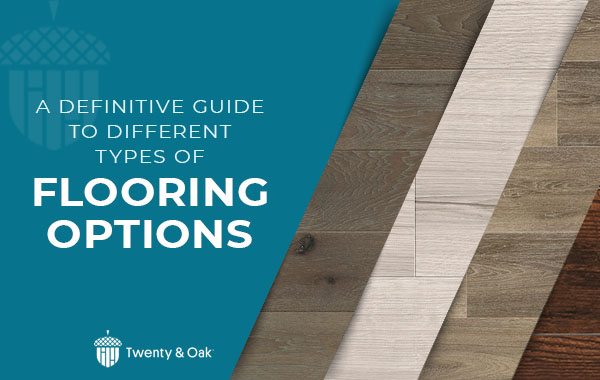
Ready to choose unique flooring types for your home? From gorgeous hardwood to affordable laminate to versatile vinyl plank and tile, there are countless options available. With so many excellent, stylish choices to select from, it can sometimes feel daunting to begin a flooring search or flooring purchase journey!
To make it a bit easier and straightforward, Twenty & Oak has broken down each type of flooring for you to explore and discover. That way, you can make the ultimate decision on the best flooring to install in your unique home so that it matches your vision and lasts for decades with outstanding performance.
Here’s a definitive guide to the different types of flooring options you can choose from.
Hardwood Flooring
Hardwood flooring is the most preferred flooring type and flooring visual with homeowners and prospective homebuyers– and we completely get it! The distinct characteristics, unmistakable texture, knots, and graining patterns truly embody natural beauty. Hardwood floors are also strong and durable enough to withstand high-traffic areas and when properly maintained can last decades in your home. Not only are hardwood floors a fantastic investment that can even increase a home’s resale value, but they can be refinished over time to restore their appearance.
Hardwood flooring also adds timeless elegance and comes in a wide-ranging variety of wood species, stain colors, and plank sizes to suit any interior decor style. You can choose from the classic hardwood styles that appear in homes with an old-world charm to more modern hardwood styles with low-gloss matte, rustic wire brushing, or saw mark surface treatments. When choosing between solid and engineered hardwood types, there are distinguishable differences and a variety of factors to consider such as your home’s climate and even subflooring materials.
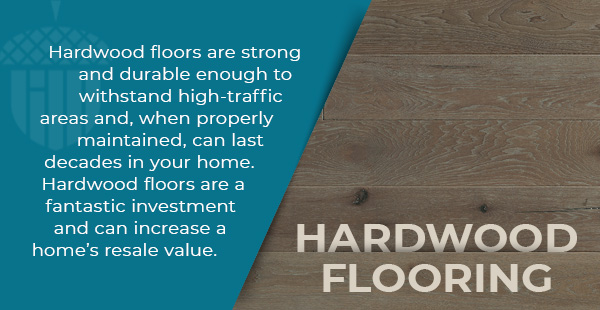
Solid Hardwood
Solid hardwood flooring is constructed of a solid plank of lumber, milled to a uniform thickness and width, with tongue and groove edges to interlock during installation. Solid hardwoods are wonderful for milder climates and, while they can be installed on the ground level with a crawl space, they are better suited for upper levels of your home. However, it’s important to note here that you must use HVAC or humidity controls. Otherwise, in high-humidity environments, solid hardwoods could cup or crown, which may result in buckling.
Engineered Hardwood
Unlike solid hardwoods, engineered hardwood flooring is suitable for any climate and can also be installed on any level in your home. The reason engineered hardwood is more versatile is because it offers a more durable construction. With multiple layers of wood veneers, topped with a stained species coated in a protective urethane layer, engineered hardwood offers a cross-layer veneer construction that is designed to reduce expansion. When it comes to refinishing options down the line, most engineered hardwood products won’t offer this capability.
Waterproof Hardwood
Waterproof hardwood flooring is a new hybrid flooring type that blends the best of both worlds. These gorgeous floors bring together the durability of waterproof rigid core flooring with the beauty of genuine hardwoods through revolutionary advanced technology. Because waterproof hardwood is so durable and versatile, it works in every single room of the house–even wet bathrooms! Waterproof hardwoods will increase your home’s resale value the same way as solid hardwoods because they are true hardwoods. Not to mention the fact that they offer complete worry-free flooring for busy households with kids and pets.
Pros and Cons of Hardwood Flooring
The benefits of hardwood flooring include a surface that’s inherently gorgeous, easy to clean, incredibly durable, and resistant to everyday wear and tear. Solid hardwood can be sanded down and refinished as desired and will add exceptional resale value to a property. Engineered hardwood and waterproof hardwood will also offer greater protection in an active home, work in more types of conditions, and offer a greater range of installation methods.
On the other hand, hardwood flooring can be expensive to purchase and lengthier to install, and solid wood can only be nailed or stapled down. Hardwood does not retain heat, and solid hardwood will experience shrinking and expansion with temperature changes. Due to its thin surface, engineered hardwood can become chipped and will not offer sanding and refinishing as desired.
Types of Laminate Flooring
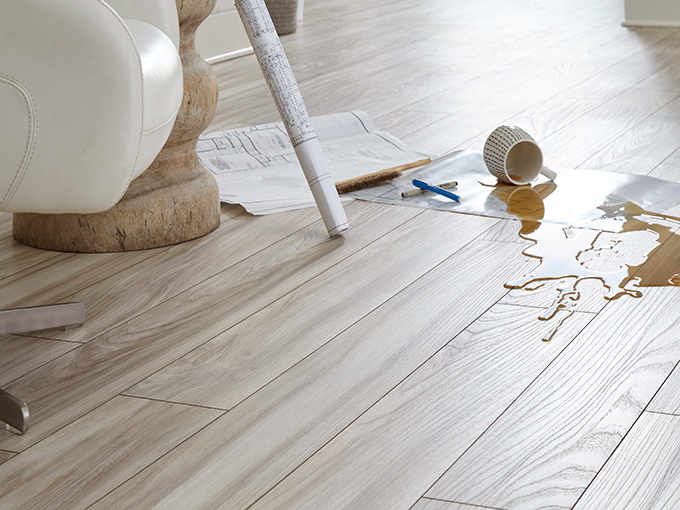
Palmetto Road Brunswick in Marshwalk
Laminate flooring is much like engineered hardwood in that it has a finished top layer and seal covering compressed fiber materials. The only distinctive difference between laminate and engineered hardwood is that laminate doesn’t have that authentic top layer of wood. Instead, laminate offers a realistic wood-like appearance through a photo-captured image.
Laminate’s photo-realistic images can also mimic the look of stone, ceramic tile, and even stained concrete. Did we also mention that laminate is much more affordable than the real thing? At a fraction of the cost, laminate flooring can make a room appear like it has original heirloom wood plank floors!
Modern laminate flooring is an outstanding water-resistant option for homeowners who desire the beautiful look of hardwood without worrying over damage or maintenance. It’s excellent for busy households with kids and is a perfect pet-friendly flooring option, capable of withstanding stains, fading, and indentations. When shopping for laminate flooring, make sure to consider the AC wear waiting that measures resistance to abrasion, impact, and stains and indicates the overall durability of a laminate product. You can also look specifically for laminate products warranted for enhanced water resistance or high-performance finishes to better suit your household conditions.
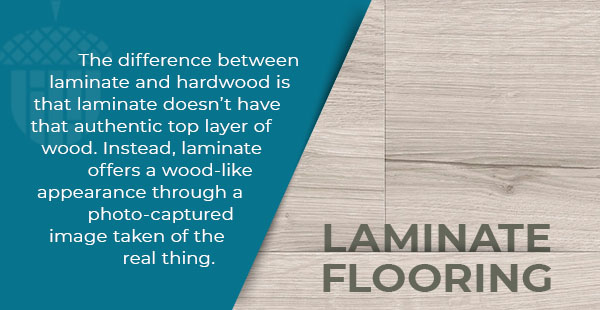
Pros and Cons of Laminate Flooring
Homeowners and builders often turn to affordable, attractive laminate floors that can replicate the look of other, more expensive flooring materials for quick renovations. Other benefits of laminate flooring include easy cleanability, low maintenance, and simple installation. Laminate flooring can become slippery if not warranted for moisture and must be replaced if damaged. Over time, laminate cannot be refinished and offers little perceived value upon resale.
Types of Vinyl Flooring
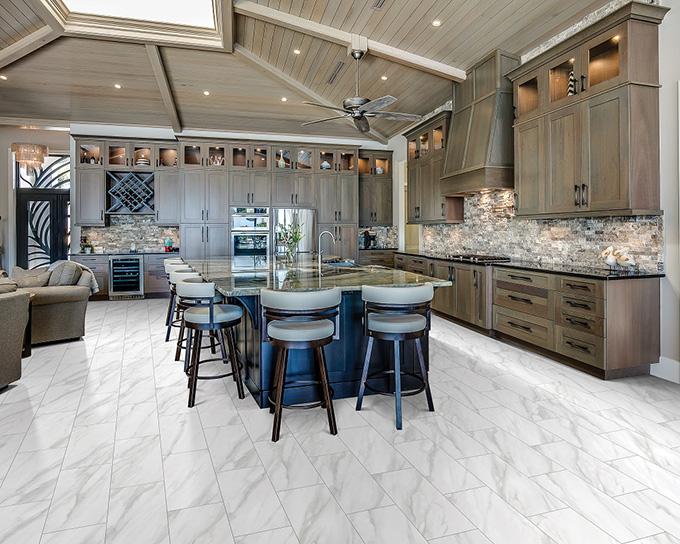
With unmatched versatility, vinyl is a resilient flooring type that is softer underfoot than most hard surface flooring products and offers inherent moisture resistance. For added durability and the aesthetic of hard surface flooring options, luxury vinyl flooring offers dent and scratch resistance and easy maintenance for active families looking to stress less within busy households. Traditional sheet vinyl flooring is equally adept at handling topical spills and puddles, making it an excellent fit for kitchens, bathrooms, mudrooms, laundry rooms, and basements.
Luxury Vinyl Planks and Tiles
Luxury vinyl plank and tile flooring, otherwise known as LVP and LVT, make a great alternative to hardwoods, stone, and ceramic flooring. Constructed of a vinyl core with a printed film and wear layer, it’s a more flexible vinyl with a rigid texture for a truly well-rounded flooring option.
LVP and LVT are extremely popular among homeowners as they can be easily installed using a glue-down or click version method. They can also be installed on any level of the home, even the moisture-prone and high-traffic areas. In fact, luxury vinyl flooring can be installed in bathrooms, kitchens and even dirt-capturing mudrooms and laundry rooms. They’re also perfect for unfinished basements and are capable of being installed over concrete subfloors with slight irregularities.
It’s important to note, however, that not all LVP and LVT promote themselves as waterproof or water-resistant. Stone plastic composite (SPC) is a vinyl flooring made up of a sturdy and dense rigid core blend of powdered limestone, polyvinyl chloride, and stabilizers. Rigid core flooring is a quite durable flooring option and it’s also completely waterproof, which means that rigid core planks will not swell or buckle.
Wood composite flooring (WPC) is constructed of a similar rigid core, manufactured with either a recycled wood pulp and plastic blend or an air-expanded polymer composite, lends a less dense construction, and is also a more lightweight material overall. Both SPC flooring and WPC flooring are completely waterproof flooring types that are easy to install and can resemble anything from natural wood to stone while offering a low price point for homeowners on a budget.
Luxury vinyl floors are exceptionally easy to clean and maintain. Plus, when exposed to water, they don’t swell or buckle the same way hardwoods do. They’re also scratch- and stain-resistant, which is another reason they’re perfect for families with kids and pets. Check out Beauflor’s Parkway LVP, which can be installed using both a locking method and glued-down method. The Beauflor Pure Collection features a 360° locking system that allows homeowners to create a unique pattern to fit their home design style.
Vinyl Sheet
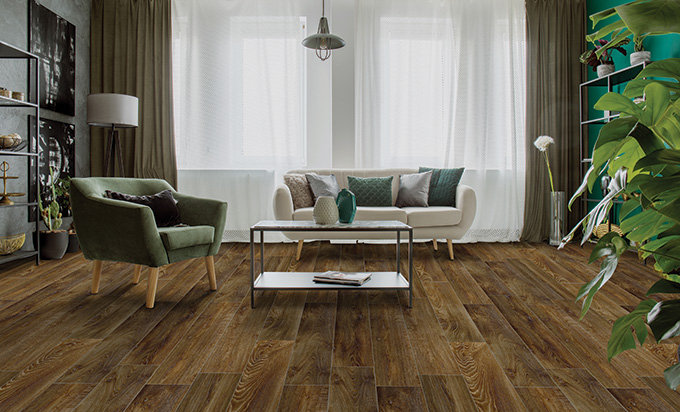
Beauflor BlackTex HD in Impressionist Spice
Vinyl sheet flooring has come a long way from its outdated reputation and is no longer the garish patterns and plastic-like floor you remember from your grandmother’s house! Much more modern and stylish than the mock pebbles and brick patterns of 30 years ago, today’s vinyl sheet can resemble anything from hardwood to stone to tile.
Vinyl flooring is an incredibly affordable option for homeowners on a budget and comes in a large roll, which has a seamless visual that you can cut to whatever custom size you need for a room. Vinyl sheet offers a single solid surface and thicker construction with a foam-like core and fiberglass base, which makes both a quiet as well as warm underfoot. The advanced top wear layer also resists scratches and scuffs from pet claws and stains from an accidental spill at a party. These floors even offer indentation resistance for something like the occasional dropped pot in the kitchen or high heels.
Typically, vinyl sheet flooring is not completely waterproof but still offers a decent level of water resistance. Should you install vinyl in a bathroom, it would be wise to line the edges with a ceramic tile barrier. However, there are the occasional waterproof exceptions: Beauflor’s BlacktexHD is a waterproof vinyl sheet flooring option and has many advantages such as noise reduction through a felt textile backing and 30 designs with an ultra-matte finish.
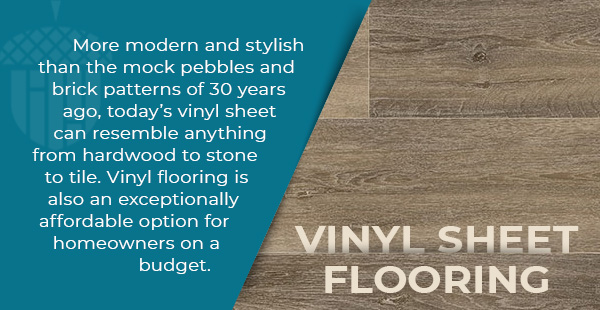
Pros and Cons of Vinyl Flooring
Although all vinyl types are affordable to purchase, there is no shortage of style when it comes to emulating real wood, stone, and tile! The benefits of vinyl flooring such as water resistance, resiliency, and easy cleanability are just a few of the valuable attributes. Thanks to the ease of installation which often includes floating floor capability, as well as suitability throughout the entire home, vinyl floors provide quick remodel and refresh solutions. Vinyl floors can however be sensitive to temperature changes, and depending on the type of vinyl, can be gouged easily by sharp objects. As far as the overall lifespan of vinyl floors is concerned, most products will have shorter longevity than other hard surface flooring options.
Types of Carpet
Carpet is still an extremely popular flooring option for homeowners who want a warm, soft surface that’s ideal for family rooms and bedrooms. Cozy and cushioned against bare feet, carpet also adds acoustical sound absorption and offers warm thermal insulation, especially when installed with high-quality carpet padding. For homes that feature exclusively hard surface flooring, chic area rugs represent an easy way to bring in the presence and appeal of soft surface flooring!
Since carpets are made with fiber loops in varying cuts, angles, and lengths, carpet construction can vary as well as the carpet pile. A carpet’s cut pile can be made of a variety of fibers, but more common fibers are nylon, polyester or polypropylene, acrylic, and wool. Some homeowners will prefer natural carpet fiber such as wool over synthetic carpet fiber, but wool carpet will cost more to purchase.
Pros and Cons of Carpet
If you crave a comfortable, soothing atmosphere in your home for premium relaxation, carpet will make every step feel like a dream. Additional benefits of carpeting include the wide-ranging selection of colors, styles, constructions, and combinations, as well as the insulation and noise barrier properties.
However, not all carpet styles are suitable for an active home. Carpet can not only be expensive to purchase but also difficult and expensive to clean if damage or tricky spills occur. Moisture is detrimental to carpet when absorbed and high-traffic areas in the home will experience wear quicker.
Types of Tile Flooring
A timeless flooring option with trademark durability, tile flooring provides homes with reliable performance with a vast array of styles to design with. Ceramic tile is an extremely versatile type of flooring, offering a seemingly unlimited amount of colors, textures, finishes, shapes, constructions, and sizes.
Ceramic tile flooring is made of a combination of clay and shale, typically glazed, and then fired, which offers an easy-to-maintain finish that can even handle bathrooms, kitchens, and areas that see a lot of moisture. A more durable tile option is porcelain tiles, which come both glazed and unglazed, that boast enhanced durability due to the manufacturing process in which tiles are fired at a high temperature.
It’s incredibly important to ensure and verify that your ceramic or porcelain tile flooring is made for floors, as opposed to a backsplash or shower wall. For the best performance in the home, you need tile that is rated for floor use to withstand everyday foot traffic as well as offer a slip-resistant coating.
Pros and Cons of Tile Flooring
One of the biggest benefits of tile flooring is the signature strength and durability that has been used for centuries. These easy-to-clean, stain-resistant surfaces can go indoors and outdoors, and inherently keep imperfections less noticeable over the years. On the other hand, all tile types are rigid and hard, and anything dropped on the unforgiving surface with certain compositions like glass or porcelain will most likely chip, break, or shatter. Tile surfaces are not warm or resilient, and thus not well suited for completing cozier living spaces.
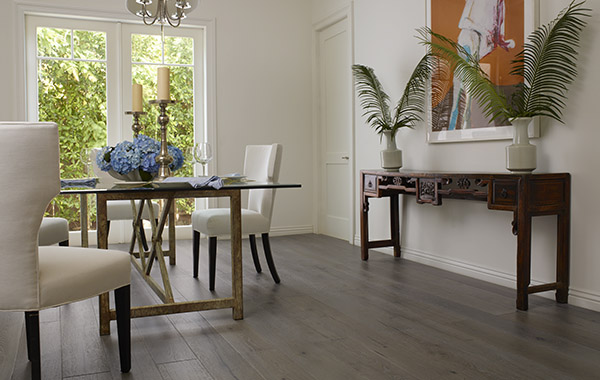
Looking for the Best Flooring?
If you’re looking for the best flooring for a particular room or space in your home, be sure to explore all the different options that can elevate your style. Take our Floor Genius quiz to help you choose the best floors or contact a dealer using our dealer locator. Additionally, our Virtual Showroom is a great way to browse different flooring types from the comfort of your home.
For more personalized help with your flooring selection, you can also schedule a free consultation with our Flooring Pros. Appointments are available by phone, email, or video platform, and you can learn more about this helpful service here!